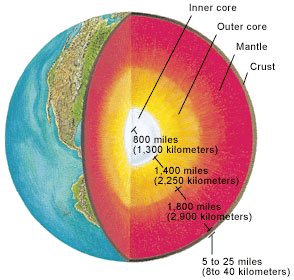When we were kids, playing in the mud, we used to dream about digging all the way to China. Wouldn’t that be fun? To escape through a tunnel into a completely different place? We didn’t realize, of course, that we’d end up in the Indian Ocean instead of among the Celestials. Our excavations never got very far, turning into mud pies as the game progressed.
And now as I stand in the yard of the little patch of earth, I call Owl Acres, I wonder what’s down there beneath my feet? What would we find on our journey to the other side of the earth? Let’s find out.
For the first 25 miles or so, what we would find is the earth’s crust—the features that make up the landscape we know. We’d find layers of dirt and rock and in time, we’d get to the hard, brittle rock that makes up the lithosphere and forms the foundations for continents. If we keep digging another twenty miles or so through that rock, we’d find the asthenosphere. This layer is hot and contains pockets of molten magma. It is softer and hotter than the rock above it, and it changes shape in response to pressures from above. This allows the brittle rock above it to move around, slowly, but definitely allowing continents to shift and move, sliding on the asthenosphere.
If we dig down another hundred and fifty miles or so, we’d reach the mantle. The next 1800 miles of digging would go through the upper mantle, then a transition zone where rocks begin to change their character under heat and pressure, and then through the lower mantle. It’s very hot because of radioactive processes down there. The rock is more dense than what we have on the surface, but over time it too changes its shape, and the solid rock actually flows, reforming itself under tremendous heat and pressure. We might find diamonds at the upper edge of the mantle, where the temperatures are already 900-1300 degrees Celsius (1650-2372 degrees Fahrenheit.). The rocks here contain a lot of iron and nickel, and lots of other minerals. As we dig further, we will encounter pockets of molten rock that will find its way through channels to the earth’s crust bringing bits of the mantle with it. Volcanoes may toss rocks out that came from hundreds of miles deep in the mantle.
After we dig through the mantle scientists tell us we’ll find a strange layer of molten rock that they call d-double-prime. This forms the border between the mantle and the core. Once we’ve gone through this layer, we’re at the outer part of the earth’s core. It is mostly molten iron and nickel, and it is literally as hot as the sun down there. In fact, the heat and pressure are so great that the center of the core can’t even melt and remains very hot solid iron and nickel. It stays that hot because of ongoing radioactive decay and nuclear radiation. It’s hard to imagine, but this hot metal core creates a magnetic field that shields the earth from deadly solar radiation. It also gives us the beautiful northern lights. Who knew!
We’ve dug our way down four thousand miles to reach the center, and now we have to dig upward away from the center for another four thousand miles to reach the other side. This half of the journey follows the process that built the earth some 4.6 billion years ago.
First the core coalesced out of iron, nickel and other matter in the solar system. Then the outer surface of it began to cool to form the mantle, the rocky shell around the core. It took Over four billion years to stabilize the layers we’re passing through, with the oldest layers in the center and the lighter, younger layers on the outside. On our way to the other side of the earth, we pass through the lower and upper mantle and the hot, plastic layer of the asthenosphere. We reach the cooler, hard and brittle rock of the lithosphere. Now we’re at the crust. But the crust here is much denser and thinner than the crust we found on Owl Acres because it’s compressed under the Indian Ocean. Once we exit the crust, we’d better start swimming! But wait. Now that we have this tunnel, we can use gravity to go back. It will only take about 45 minutes. Gravity would pull us to the center, accelerating as we go, and then slowing us down once we pass the center and start up toward the surface again. That sounds like fun, don’t you think?
Back on Owl Acres, I try to imagine that 8,000-mile journey. The earth formed from the inside out, and much of its story is hidden deep below the surface under tremendous heat and pressure. The crust, though, that thinnest layer on the outside of the ball, has its own stories. With patience and hard work, those stories are being discovered and told.
Photo by: NASA
